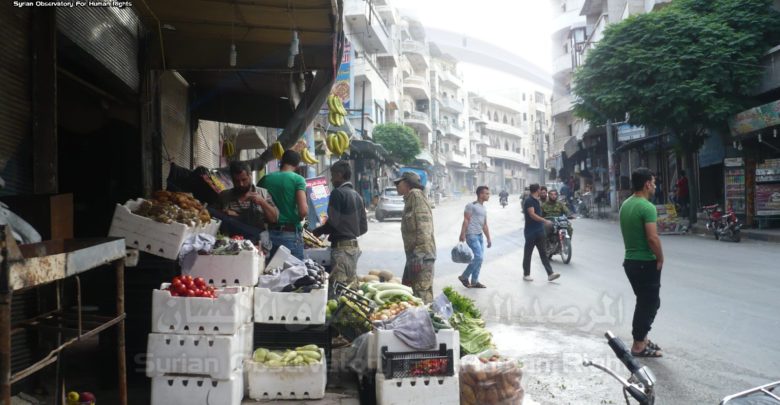The rise in USD exchange rate burns markets in Idlib, weakens citizens’ purchasing power as displacement and unemployment spread
Idlib markets have been witnessing a significant decline over the past few months in terms of buying and the demand of civilians in the markets, due to the large increase in most of the goods such as food and other items, along with the spread of the unemployment phenomenon significantly, coinciding with the military operations that led to the displacement of hundreds of thousands of civilians under harsh living conditions, carrying the burden of displacement with them from renting houses, buying tents, securing water, electricity, food, drinking water, and many other basic items in the establishment of their new homes, where the majority of them left their homes leaving their livelihood and the tragedy of displacement, this coincided with a sharp fall in exchange rate of the Syrian pound against the U.S. dollar, where the liberated are is considered as a free economic area which is directly affected by the exchange rates, which increased the size of the problem and made the stagnation prevails among the traders in both selling and purchasing, and negatively affected the consumers who are displaced people mostly, and the markets recorded insane rise in prices of imported materials, this rise also coincides with the approach of winter this year, where families in Idlib used to prepare winter supplies of storing milk derivatives, jams, Makdous, walnuts, figs, and raisin, in contrast, despite the high price of imported materials, local products are witnessing a steady in price and in some great decline, due to the weak purchasing power of citizens, and the average daily needs of a family is 5000 Syrian pounds or about 10 American dollars to buy food supplies and pay for water, electricity, treatment, clothing, transportation, and services, also the displaced people suffer from other costs such as renting a house or a piece of land to build a tent, while the people whose purchasing power is weak only buy the this they need the most, such as bread, water, and some types of vegetables, staying as far as possible from the materials that are considered luxuries in the liberated areas only
Several other factors contribute to this great rise, after the Syrian regime forces controlled fertile agricultural areas of the northern and western countryside of Hama, which was considered the food reservoir for the market in the north of Syria, also the taxes and royalties imposed by the rescue government negatively affect most of the trade fields as they are ultimately taken from the pocket of the consumer, also the greed of some of the traders of the crises taking advantage of the decline of the Syrian currency or its rise has only made things worse, it worth mentioning that the prices of food, meat, and heating materials in the northern countryside of Idlib are updated daily in accordance with the exchange rate of the SYP against the USD, where in the first week of this month, prices were as follows: imported fuel was affected due to the rise of dollar exchange price, while the liberated oil kept its value locally, the benzine recorded 550 SYP, gasoline (diesel) 300 SYP, and the gas cylinder 6100 SYP, while bread is sold according to the ovens that are partially supported by organizations or those which are operating freely, and the lamb meet record 45000 SYP per kilo, and the chicken 800 SYP, and regarding the vegetables and fruits, there was also an increase in prices of the imported items, while prices of the vegetables and local products declined.

